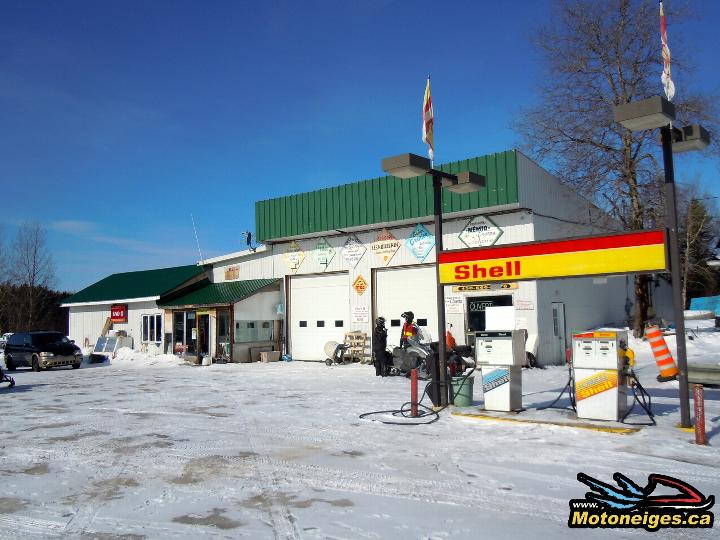
Gas station in Parent, Haute-Mauricie, sector Gouin
Snowmobilers are very often surprised by the price of fuel sold by outfitters in isolated or remote areas. They sometimes think, wrongfully, that the retailer makes too much profits and takes advantage of his remoteness to increase the price of fuel.

Lands and distances that otherwise would not be accessible without refueling points
Firstly, we have to consider that because roads are icy or even closed in winter, outfitters and other restauration or lodging accomodations must sometimes fill up their reservoirs to the top as soon as in October in order to have enough fuel in stock to response to their clients’ needs all winter long. After these dates, many suppliers do not want to send their fuel tanker on nordic logging roads considering all the risks involved in bad weather conditions. For the isolated villages like those in Basse-Côte-Nord, fuel is brought by boat until navigation is blocked by frozen waters.
Also, the outfitters and fuel retailers must, to their own expenses, install special equipments to stock the fuel in compliance with environmental standards and regulations on petroleum products. The equipments must be safe and must be able to contain leakage in order to reduce damages if an incident occurs. So, the equipments must be safe and must not be a risk for the pump attendant or the clients. The cost of such a fuel installation can easily reach 20 000 $ to be in compliance with regulations.
Then, when fuel is delivered by land or by sea in these small businesses, transportation fees are added to the fuel price. These additional fees can be from 0,10 $ to 0,20 $ per liter; gas stations on usual Québec road network do not have to pay these additional fees. Then, these transportation fees are distributed on each fuel liter, which explains the higher price of fuel at pump here than in your populated region.
Fuel and transportation must be paid on delivery and without delay. So, the price of the gas bought in October for all winter season must be paid in advance by the small enterprises that cannot afford to be short of fuel for their clients. A remote refueling point must take measures to be reliable, thus must have enough fuel in stock to last all season long.
If the fuel price decreases in the following months, the price paid by the small enterprise in October cannot decrease as it does on the Québec road network. So, in this situation, stock is expensive and the price must stay high.

Harrington Harbour Island, its store and its gas station accessible by boardwalk
In order to satisfy a diversified clientele, many retailers also keep reserves of diezel and seaplane or jet fuel along with premium fuel. The price per liter of these 3 products cannot be compared with the regular gasoline that is not convenient for all types of vehicles.
The same rules apply for convenience stores. Transportation fees in backcountry are a major additional element that impacts the retail price. A bottle of wine, a liter of milk or a bottle of aspirins is expensive once arrived here due to transportation and labor costs. We must keep this in mind.
Fuel and products sold in convenience store are not really an important source of revenues for these small enterprises. Snowmobilers and quadists must rather consider these services as accomodations offered to them, as an emergency supply instead of a lucrative market.

Chevery on Basse-Côte-Nord, its convenience store and gas station
In mid-October 2015, while premium fuel is sold 1,26 $ in Trois-Rivières and Sept-Iles, it is sold 1,72 $ at the outfitter Barrage du Réservoir Gouin and 1,73 $ in the villages of Basse-Côte-Nord.
After these explanations, you will understand that the price paid in backcountry and isolated places is really affordable considering the above-mentionned fees and requirements. Remember that it is firstly a service of refueling for the clients, not a merchant trying to rip you off.
If furthermore you pay with a credit card, fees of 3 % are added on the total bill. It may be minor if you fill up any off-road vehicle, but with 30 000 liters in stock, it means another amount of 1 500 $ added to the fuel price, its transportation and storage paid by the merchant.
Now that you understand, please keep smiling when you fill up your tank and be grateful to the outfitter who allows you to continue your adventure in backcountry without having to carry auxiliary fuel tanks tied up to your machine.


